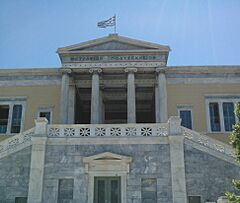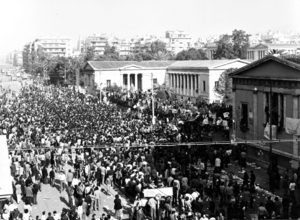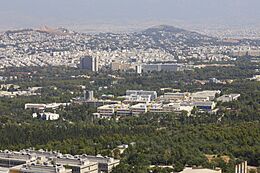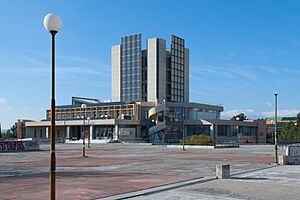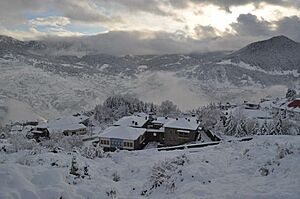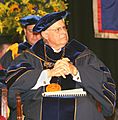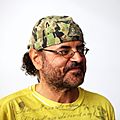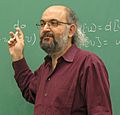National Technical University of Athens facts for kids
|
Εθνικό Μετσόβιο Πολυτεχνείο
|
|

Seal of NTUA
|
|
|
Other names
|
Athens Polytechnic National Metsovian Polytechnic |
|---|---|
| Type | Public higher education institution |
| Established | December 31, 1836 (OS) January 21, 1837 (NS) |
|
Academic affiliations
|
TIME, CESAER |
| Budget | 5,065,956.40 (2024) |
| Rector | Andreas Boudouvis |
|
Administrative staff
|
512 |
| Students | 23,914 |
| Location |
,
Greece
|
| Campus | Patision Complex (central Athens), Zografou campus (Central Athens district) |
| Colors | White & gold |
| Mascot | Prometheus |
The National (Metsovian) Technical University of Athens (NTUA) is a famous university in Athens, Greece. People sometimes call it Athens Polytechnic. It got the name "Metsovian" to honor important people like Nikolaos Stournaris and Eleni Tositsa. These people were from a town called Metsovo and helped pay for the university.
NTUA started in 1837 as a small school for training craftsmen. It was called the Royal School of Arts. As Greece grew, this school became the main place for engineering degrees until the 1950s. Its first campus is in central Athens on Patision Avenue. It has beautiful old buildings designed by architect Lysandros Kaftantzoglou. A newer campus, the Zografou Campus, was built in the 1980s.
Today, NTUA has nine main schools. Eight of these schools teach different types of engineering, including architecture. One school focuses on applied sciences, like math and physics. Most courses for a first degree last five years. The university has about 700 teachers and many staff members. Around 8,500 students are studying for their first degree, and about 1,500 are doing advanced studies. Most schools are at the Zografou Campus, but the School of Architecture is still at the older Patission Complex.
Contents
History of NTUA
NTUA was officially started on January 21, 1837. It was first known as the "Royal School of Arts." It began as a part-time school, teaching skills to builders and craftsmen. This helped meet the needs of the new country of Greece.
In 1840, the school became more popular. It was upgraded to a full-time technical school. More courses were added, and the school moved into its own building.
How the School Changed
In 1843, big changes happened. Three main parts were created:
- A part-time school for skills.
- A daily school.
- A new "Higher School of Fine Arts."
This new part taught both fine arts and engineering. It quickly grew into a major higher education place. The word "arts" back then meant both technical jobs and fine arts. Even now, the university has an architecture school that is connected to fine arts.
The name "Polytechnic" came in 1862. This was when many new technical courses were added. The school kept changing and growing until 1873. So many students wanted to learn advanced technical skills that the school needed a new, bigger campus.
Moving to a New Home
In 1873, the university moved to its new campus on Patision Street. It became known as "Metsovion Polytechnion." This name honored the people from Metsovo who paid for the new buildings. Even though the Patission Street campus was not finished, the many students made the move urgent.
In 1887, the university was split into three technical schools: Structural Engineering, Architecture, and Mechanical Engineering. All these degrees took four years. At this time, the government officially recognized the institute as a technical education center. This was a very important step for its growth.
In 1914, new schools were created. The university was officially named "Ethnicon Metsovion Polytechnion" (National Metsovian Polytechnic). It came under the government's supervision. More technical schools were formed, and by 1917, NTUA had changed a lot. The old "School of Industrial Arts" was divided into several higher schools. These included Civil Engineering, Mechanical & Electrical Engineering, Chemical Engineering, Surveying Engineering, and Architecture. Later, schools for Naval Engineering and Mining and Metallurgical Engineering were added. The Mechanical & Electrical Engineering school also split into two separate schools. This is mostly how the schools are set up today.
In 1923, former students of NTUA helped create the Technical Chamber of Greece. This group gives professional licenses to all engineers in Greece.
In 1930, the Athens School of Fine Arts became its own separate school. This allowed both schools to grow, one for technical studies and one for fine arts.
From 1941 to 1944, NTUA played a big part in Greece's history. During World War II, Greece was occupied by Germany. NTUA became a center for the Greek Resistance in Athens. Students actively fought against the occupation.
The Uprising for Freedom
The Athens Polytechnic uprising in November 1973 was a key moment in Greece's fight against a military government that took power in 1967. This important event started with student protests at NTUA. It ended with the government using force against the students.
The uprising began with student protests and occupations. The government responded with more and more violence. The final clash started on November 14. Students built barricades inside NTUA's Patission Complex. They started a pirate radio station, asking people to rebel.
On November 17, the military government used army tanks to break through the gates. They attacked the students and their supporters. Many people were hurt, and some were killed. Many more were arrested and tortured. The uprising made the Greek people very angry. The military government was badly damaged by this public outcry. It fell in 1974, after the Turkish invasion of Cyprus.
The Polytechnion Uprising is remembered every year on November 17. Students, political groups, and the Greek government honor it as a symbol of the fight for freedom and democracy. A monument at the NTUA campus honors those who fought against the military government.
NTUA's Emblem
The symbol of NTUA shows Prometheus bringing fire to humans from the gods. In Greek mythology, Prometheus went against the Olympian gods. He gave fire to humanity, which represented technology, knowledge, and civilization. This symbol shows that NTUA wants to solve real human problems and help people.
The emblem is round and black. It has Prometheus in the middle, holding a lit torch. On the right, there is an altar with a flame. The name "Prometheus the Fire-bringer" is written on the sides. On the left, the name ΕΘΝ • ΜΕΤΣΟΒ • ΠΟΛΥΤΕΧΝΕΙΟΝ is written in capital letters. The year NTUA was founded is also there in Greek numerals.
A Greek artist named Nikos Hadjikyriakos-Ghikas designed the emblem in 1954. He was also a professor at the university. His first drawings for the emblem are kept in the Benaki Museum.
What You Can Study at NTUA
Schools at NTUA
The National Technical University of Athens has nine main schools. These schools are divided into 33 departments.
- School of Applied Mathematical and Physical Sciences (started 1999)
- School of Electrical and Computer Engineering (started 1975)
- School of Civil Engineering (started 1887)
- School of Mechanical Engineering (started 1982)
- School of Architecture (started 1917)
- School of Chemical Engineering (started 1917)
- School of Rural, Surveying and Geoinformatics Engineering (started 1917)
- School of Mining and Metallurgical Engineering (started 1946)
- School of Naval Architecture and Marine Engineering (started 1969)
- School of Applied Mathematical and Physical Sciences
- Department of Mathematics
- Department of Physics
- Department of Mechanics
- Department of Humanities, Social Sciences and Law
- School of Electrical and Computer Engineering
- Department of Signals, Controls and Robotics
- Department of Computer Science
- Department of Εlectric Power
- Department of Electromagnetics, Electrooptics and Electronic Materials
- Department of Industrial Electric Devices and Decision Systems
- Department of Communications, Electronics and Information Systems
- Department of Information Transmission Systems and Material Technology
- School of Civil Engineering
- Department of Structural Engineering
- Department of Water Resources, Hydraulic and Maritime Engineering
- Department of Transportation Planning and Engineering
- Department of Geotechnical Engineering
- Department of Engineering Construction and Management
- School of Mechanical Engineering
- Department of Fluid Mechanics Engineering
- Department of Thermal Engineering
- Department of Nuclear Engineering
- Department of Mechanical Constructions and Automatic Control
- Department of Manufacturing Technology
- Department of Industrial Management and Operational Research
- School of Architecture
- Department of Architectural Design
- Department of Urban and Regional Planning
- Department of Interior Design and Landscaping
- Department of Building Technology-Structural Design and Mechanical Equipment
- School of Chemical Engineering
- Department of Chemical Sciences
- Department of Process and Systems Analysis, Design and Development
- Department of Materials Science and Engineering
- Department of Synthesis and Development of Industrial Processes
- School of Rural, Surveying and Geoinformatics Engineering
- Department of Topography
- Department of Geography and Regional Planning
- Department of Infrastructure and Rural Development
- School of Mining and Metallurgical Engineering
- Department of Geological Sciences
- Department of Mining Engineering
- Department of Metallurgy and Materials Technology
- School of Naval Architecture and Marine Engineering
- Department of Ship Design & Maritime Transport
- Department of Ship Hydrodynamics
- Department of Marine Engineering
- Department of Marine Structures
How Studies Work
First Degrees
NTUA's school year has 10 semesters. Each semester lasts 18 weeks. This includes 13 weeks of classes, a two-week break, and three weeks for exams. The tenth semester is for students to work on their final project, called a diploma thesis. This project must be related to their studies. Students have at least one full semester to prepare it. After finishing, they take an oral exam.
Students can also do summer "training" projects. These happen at factories or production places. They are an optional course for some engineering fields. The European Union helps pay for some of these projects.
Advanced Degrees
NTUA offers 20 different advanced courses. These lead to a Post Graduate Specialization Diploma. They usually last at least 17 months. One course is in Business Administration, done with another university. NTUA also takes part in nine other advanced programs with other Greek universities. After getting this diploma, students can work on a doctoral thesis to earn a PhD.
Teachers and Staff
NTUA has many dedicated teachers and staff. They help students learn and grow.
| School | Lecturers | Associate professors | Assistant professors | professors | Emeritus | Total |
|---|---|---|---|---|---|---|
| School of Applied Mathematics and Physics | 5 | 35 | 27 | 40 | 13 | 120 |
| School of Electrical and Computer Engineering | 1 | 11 | 12 | 52 | 20 | 96 |
| School of Civil Engineering | 12 | 16 | 17 | 23 | 13 | 81 |
| School of Mechanical Engineering | 5 | 12 | 8 | 20 | 10 | 55 |
| School of Architecture | 18 | 20 | 9 | 34 | 38 | 119 |
| School of Chemical Engineering | 6 | 13 | 10 | 48 | - | 77 |
| School of Rural and Surveying Engineering | 7 | 14 | 5 | 15 | 8 | 49 |
| School of Mining and Metallurgical Engineering | 4 | 10 | 9 | 14 | 14 | 51 |
| School of Naval Architecture and Marine Engineering | 0 | 4 | 5 | 15 | 5 | 29 |
Research and Innovation
NTUA is very active in research. Research and teaching are both important goals for the university. Research is managed by staff, but students can also take part. There are several offices that help with research.
Research gets money from NTUA itself, or from public and private groups.
University Rankings
| University rankings | |
|---|---|
| Global – Overall | |
| ARWU World | 801–900 (2024) |
| QS World | =355 (2026) |
| THE World | 801–1000 (2025) |
| USNWR Global | =508 (2025) |
The National Technical University of Athens is one of the best universities in Greece. In 2025, the QS World University Rankings placed NTUA at #321 globally. For Engineering & Technology, it was ranked #142. In Europe, NTUA was #180. For Civil and Structural Engineering, NTUA was in the top 51-100 in 2024. Its highest rank in this area was #25 in 2013. NTUA has a high score for how often its research is cited by others. This shows its important contributions to science and technology. In 2022, 130 researchers from NTUA were among the top 2% most cited scientists in the world.
How NTUA is Evaluated
Between October 2015 and July 2016, a group called the Hellenic Authority for Higher Education (HEHA) checked all Greek universities. Their report for NTUA was given in November 2016. The report said that NTUA is well-organized. It has an excellent reputation because of its students and teachers. They have helped Greek science and technology a lot. The university leaders have clear goals for teaching, managing, and research. They also have plans to improve things.
Some challenges include adapting to changes in education and legal issues. The university offers many different subjects. It has strong connections with businesses. It also works hard to ensure good quality education. However, it faces problems like government involvement and not enough money. It also needs to work better with outside groups and improve its internal services.
University Campuses
Patission Complex
The Averof building is a very important and beautiful building in central Athens. It is a great example of Neoclassical architecture. Its design was inspired by the ancient buildings on the Athenian Acropolis. Construction started in 1862 and finished in 1878. For over 125 years, the building was used continuously. It also housed the National Gallery and showed items from Heinrich Schliemann's archaeological finds.
Over time, the Averof building needed a lot of repair. It was restored and updated so it could be used for teaching again. The project was successful, and the building reopened in 2010. It even won a big award called Europa Nostra in 2012.
Zografou Campus
The main campus is in the Zografou area of Athens. All schools except architecture are here. The architecture school stays at the Patission Avenue location for historical reasons. The main campus covers about 190 acres. It is about 6 kilometers from the center of Athens. It has buildings with classrooms, labs, libraries, gyms, a main library, a computer center, and a medical center.
The School of Applied Mathematics and Physical Sciences is in the middle of the campus. Next to it is the Mining and Metallurgical Engineering School. The Civil Engineering School and the Rural and Surveying Engineering School are both on the southwest side. Mechanical Engineering, Chemical Engineering, Naval Engineering, and the new Electrical Engineering School are near the center. The old electrical engineering buildings are on the northeast.
Getting Around Campus
There are roads on campus, so you can get to all buildings by bike or car. There are also internal buses that drive around the campus. They stop at eight different places. You can enter the campus through three main gates. There are 2,000 parking spots near the main buildings. The campus is close to the Katechaki metro station. This makes it easy to reach from anywhere in Athens. Also, six different city buses go to the campus.
Central Library
The NTUA Central Library is on the Zografou campus. It has been open since 1914. It was the first library in Greece with a full index system. Today, it is one of the biggest technical libraries in the country. It has over 215,000 books and 100,000 scientific magazines. Anyone can use the library for studying. Students, teachers, and researchers can borrow books.
The central library building also holds NTUA's historical library. This special collection is unique in Greece. It has about 60,000 old and rare books, magazines, maps, and encyclopedias. These items were published from the 17th century until 1950.
Other Cool Places
Lavrion Technological and Cultural Park (LTCP)
The Lavrion Technological and Cultural Park (LTCP) is a place for science, education, business, and culture. It started in 1992. It is located where an old French Mining Company used to be. NTUA helped create it.
LTCP connects scientific research from Athens with businesses. It also hosts cultural events to promote the history of the Lavreotiki area. The LTCP area is a special example of old industrial buildings. It is now a place for excellent businesses and research.
LTCP helps research, education, and technology. It is the only technology park in Attica that focuses on modern technology. This includes information technology, electronics, telecommunications, robotics, and environmental technology.
Institute of Communication and Computer Systems (ICCS)
The Institute of Communication and Computer Systems (ICCS) started in 1989. It is a research group that helps NTUA's goals. ICCS does scientific research in many areas. These include AI (Artificial Intelligence), computer networks, mobile communications, and energy.
Metsovion Interdisciplinary Research Center (MIRC)
The Metsovion Interdisciplinary Research Center (MIRC) was founded in 1993. It aims to protect and develop mountain areas and local European cultures. It also provides continuing education. MIRC conducts research, studies, seminars, and conferences. It wants to create a European network with similar groups. The goal is to help Metsovo become a European center for education, research, and culture through NTUA.
Student Life and Fun
Music Department
The NTUA Music Department started in 1960. It has a choir and a string orchestra. It also offers free lessons for instruments like piano, guitar, and cello. The music groups often perform for the public.
Dancing Department
The Dancing Department started in 1990. Students run it. It has groups for Greek traditional dances, European and Latin Ballroom dances, Salsa, and tango. The groups meet weekly and perform often. Lessons are free for students, alumni, and teachers.
Theatrical Group
The Theatrical Group started in 1991. It is run by students. It teaches acting and performs for the public. Students can join for free. The group also has a separate percussion lessons group.
Sports
NTUA has great sports facilities at its Sports Center. It covers about 3,500 square meters. There are tennis and soccer courts, a track, a sauna, and ping pong tables. More than 40 sports teams exist. You can do aerobics, yoga, Pilates, basketball, volleyball, soccer, handball, and martial arts on campus. Outside campus, you can do swimming, polo, rowing, yachting, and more.
Every year, there are championships between the university's schools. NTUA student teams have won many awards in national and international university games.
Open Source Software
There is a student group that promotes open source software at the university. NTUA also uses open source software in its labs. It hosts mirrors for major open source projects, with lots of free software available.
Learning Foreign Languages
English, French, German, and Italian are taught at NTUA. Students who are not on exchange programs must choose one as a required course. For students from other countries, NTUA offers free Greek language courses. These courses help foreign students understand and communicate in Greece.
International Connections
NTUA is part of several international organizations:
- CESAER – A group of European schools for advanced engineering education and research.
- EEGECS – A network for European education in surveying and mapping.
- SEFI – The European Society for Engineering Education.
- TIME – Top Industrial Managers Europe.
Student Groups
NTUA has many active student groups:
- NTUA Students' Formula Team
- Society of Naval Architects and Marine Engineers, NTUA
- Athens Local BEST Group
- Electrical Engineering STudent's European Association Local Committee of Athens (EESTEC)
- Euroavia Athens, NTUA
- International Association for the Exchange of Students for Technical Experience (IAESTE)
- American Institute of Chemical Engineers Student Chapter (AIChE)
Famous People Who Studied Here
Many notable people have studied at NTUA, including:
- Nicholas Ambraseys – a professor of engineering seismology.
- Dimitris Anastassiou – helped develop the MPEG-2 algorithm.
- John Argyris – one of the founders of the finite element method.
- Dimitri Bertsekas – a professor of engineering at MIT.
- Georges Candilis – a famous architect.
- Giorgio de Chirico – a Greek-born Italian artist.
- Constantinos Daskalakis – a computer scientist and professor at MIT.
- John Iliopoulos – helped create the Standard Model of particle physics.
- Linda P. B. Katehi – a former Chancellor of UC Davis.
- Emmanouil Korres – a professor and restoration architect.
- Max Nikias – a former president of the University of Southern California.
- Constantine Papadakis – a former president of Drexel University.
- Christos Papadimitriou – a computer scientist and award winner.
- Alexis Tsipras – a former Prime Minister of Greece.
- Iannis Xenakis – a very important composer and architect.
- Mihalis Yannakakis – a computer scientist and award winner.
See also
 In Spanish: Universidad Politécnica Nacional de Atenas para niños
In Spanish: Universidad Politécnica Nacional de Atenas para niños
- Athens Polytechnic uprising
- Polytechnic (Greece)
- List of universities in Greece
- Top Industrial Managers for Europe
- Open access in Greece



